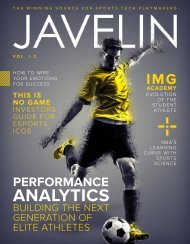Javelin 1.1
Javelin Magazine, the only source of sports tech content generated directly by the play-makers and stakeholders in the sports tech industry. Javelin is entirely original content. We provide direct access to, and one-on-one conversations with, top executives in sports technology.
Javelin Magazine, the only source of sports tech content generated directly by
the play-makers and stakeholders in the sports tech industry.
Javelin is entirely original content. We provide direct access to, and one-on-one
conversations with, top executives in sports technology.
Create successful ePaper yourself
Turn your PDF publications into a flip-book with our unique Google optimized e-Paper software.
TITAN SPOTLIGHT FEATURE: BRIAN KOPP<br />
SportVU and Catapult and others, you're talking databases<br />
of information. Now machine learning algorithms are<br />
required to really get insight out of that volume of data.<br />
Then it becomes another one of those dynamics where<br />
introduction to a lot of data is good, but needs to be harnessed<br />
and used the right way. At the end of the day, as<br />
much as we talk about big data in sports, the data that we<br />
capture is minuscule compared to a lot of other industries.<br />
DI: Data collection and analysis has increased dramatically.<br />
What have been some of your best practices on how<br />
teams, coaches and organizations can stay on top of this?<br />
BK: To me, it all starts with organizational structure. Traditionally,<br />
you had analytics in a silo, training in a silo,<br />
coaching in a silo, and front office in a silo. They talked to<br />
each other, but they did most of their work independently.<br />
So, there were disconnects between the decisions that<br />
were made, or how information was used.<br />
The most successful organizations are starting to communicate,<br />
collaborate, and understand that what goes on<br />
when you're out on the practice field impacts what goes<br />
on in the training room, which impacts decision-making<br />
in the front office. Having more complete information for<br />
communication is key. Some of that has been accelerated<br />
by technology. I think the best practices are those that<br />
don't view those as independent jobs, but do it as a collaborative<br />
team effort.<br />
Once you've done that, the way that technology and<br />
use of data comes in becomes pretty core to how they<br />
handle that as well. You look at things holistically. That’s<br />
true at the pro level, and at the college level.<br />
DI: What does digital transformation look like to you and<br />
how are you integrating that to better understand the<br />
customer experience?<br />
BK: Good question. We've gone through a couple different<br />
evolutions as an industry.<br />
Digital transformation is taking different data that's<br />
being used in a lot of different ways, presenting it and<br />
using it in unique ways. Take augmented reality. I think the<br />
best augmented reality experiences are going to be those<br />
that integrate cool graphics with really cool and interesting<br />
insights that are based on the data you're collecting.<br />
A few years ago, the emphasis was around collecting<br />
and getting access to data. We've now evolved into more<br />
analytics, visualization, and application of that data. I think<br />
The most successful<br />
organizations are<br />
starting to communicate,<br />
collaborate, and<br />
understand that what<br />
goes on when you're<br />
out on the practice field<br />
impacts what goes on in<br />
the training room, which<br />
impacts decision-making<br />
in the front office. — Brian Kopp<br />
that's where a lot of the transformation will take place. It's<br />
matching up with the demands of the market, because<br />
people don't want to just have the passive experience.<br />
They want to be more interactive with what they're seeing<br />
across the board.<br />
DI: What companies come to mind that are driving sports<br />
markets?<br />
BK: Young start-up companies are going to get some things<br />
off the ground. One of the key players will be apparel<br />
companies - Nike, Under Armor, Adidas. They've been in<br />
the space, and they have the brand credibility. This whole<br />
technology / data area of the landscape is not something<br />
they've traditionally spent a lot of time cultivating. So rather<br />
than do it themselves, I think there will be some nimble<br />
startups that the apparel companies are going to [rely on].<br />
These will be companies that are able to connect a few<br />
of the dots within the industry.<br />
I also think major technology companies – like Intel,<br />
SAP, or Microsoft - and others who have the market clout<br />
will take some of these ideas and bring them to market<br />
in a much bigger way.<br />
6 | DIRECT–INTERFACE.COM






